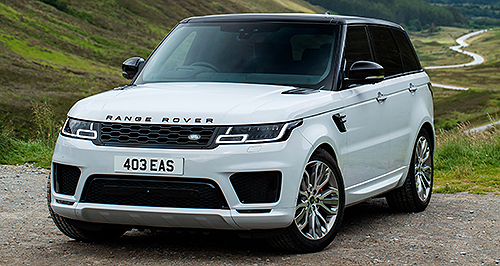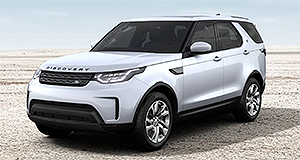Future models - Land Rover - Range Rover SportRange Rover Sport scores diesel-hybrid powerLand Rover adds three new diesel-hybrid powertrains to Range Rover Sport range24 Jul 2020 LAND Rover has given its Range Rover Sport premium SUV an extensive update ahead of the 2021 model year, one that brings a string of new diesel hybrid powertrains and subsequent retirement of the established diesel mills.
Underpinning all three of the new hybrid powertrains is the same turbocharged 3.0-litre inline six-cylinder diesel mill paired with a 48V mild-hybrid system producing three different levels of power and torque.
In the least powerful D250 guise, the setup produces a healthy 183kW/600Nm with both figures jumping to 221kW/650Nm in the D300.
At the top of the diesel range is the D350 which produces a solid 258kW and mountainous 700Nm worth of pulling power, resulting in a 0-100km/h time of 6.9 seconds and the subsequent discontinuing of the current V6 and V8 diesel powerplants.
The broad changes have not been applied to the petrol offerings, with the range being kicked off by the P300, powered by the now familiar 2.0-litre four-cylinder engine good for 221kW/400Nm.
Next up is the P400e plug-in hybrid (PHEV) which combines the P300’s internal combustion engine with a 105kW electric motor to produce a combined 297kW of power and 640Nm of torque.
These figures are enough to propel the more than two-tonne hybrid family hauler from 0-100km/h in 6.7 seconds and return a combined fuel figure of just 3.3 litres per 100km.
Jaguar Land Rover engine commodity chief engineer Jonathon Harris said the ‘Ingenium’ family of engines provide world-class performance and efficiency in both mild and plug-in hybrid forms.
“The family of clean, refined and efficient Ingenium engines has evolved and expanded to meet the needs of our customers across the world,” he said.
“Designed, engineered and manufactured in-house in the UK, our state-of-the-art petrol and diesel engines now provide a choice of inline four and six-cylinder powerplants across the Range Rover Sport line-up.”
At the top of the petrol-powered tree are the classic supercharged 5.0-litre V8s producing 386kW/625Nm in P525 guise (0-100km/h in 5.3 seconds) and a monstrous 423kW/700Nm in flagship SVR guise.
All Range Rover Sport variants, regardless of powertrain, rely on an eight-speed automatic transmission to send power to all four wheels.
In terms of styling, Land Rover has changed almost nothing on the exterior or interior of the Sport apart from updating the LED headlights.
While local pricing and specification levels are yet to be confirmed, we do know that some of the global standard equipment includes Apple CarPlay and Android Auto, 4G hotspot, dual 10-inch Touch Pro Duo touchscreens, voice recognition, head-up display, 12-inch digital cockpit, LED headlights, updated Cabin Air Ionisation system and 10-colour ambient lighting.
Adjustable air-suspension underpins every variant across the range with decent off-road capabilities still ensured by the Terrain Response 2 system and a two-speed transfer case, although a single speed unit paired with a Torsen differential is also available.
Land Rover chief creative officer Gerry McGovern said: “The Range Rover Sport is a unique statement of performance with an assertive and powerful design. Its refined appearance speaks to the modernity of the Range Rover family, while a series of unique aesthetic touches mark out its sporting nature”.
Jaguar Land Rover Australia chalked up 1049 Range Rover Sport sales through the first half of this year, accounting for 11.9 per cent of the $70,000+ large SUV segment and making it the third most popular model behind the Mercedes-Benz GLE (1637) and BMW X5 (1430).  Read more22nd of April 2020  Hybrid power for Land Rover Discovery Sport, EvoqueLand Rover Discovery Sport and Range Rover Evoque will score PHEV power next yearAll future models Alfa Romeo Alfa Romeo Abarth Abarth Audi Audi Aston Martin Aston Martin BMW BMW Bentley Bentley Chrysler Chrysler Chevrolet Chevrolet Dodge Dodge Citroen Citroen Ferrari Ferrari DS DS Ford Ford Fiat Fiat FPV FPV Foton Foton Haval Haval Great Wall Great Wall Honda Honda Holden Holden Hyundai Hyundai HSV HSV Isuzu Isuzu Infiniti Infiniti Jeep Jeep Jaguar Jaguar Lamborghini Lamborghini Kia Kia Lexus Lexus Land Rover Land Rover Mazda Mazda Maserati Maserati Mercedes-Benz Mercedes-Benz McLaren McLaren Mini Mini Nissan Nissan Mitsubishi Mitsubishi Peugeot Peugeot Opel Opel Proton Proton Porsche Porsche Renault Renault Ram Ram Saab Saab Rolls-Royce Rolls-Royce Smart Smart Skoda Skoda Subaru Subaru SsangYong SsangYong Tesla Tesla Suzuki Suzuki Toyota Toyota Volvo VolvoRange Rover Sport pricing
Motor industry news |
Click to shareLand Rover modelsResearch Land Rover All future models Alfa Romeo Alfa Romeo Abarth Abarth Audi Audi Aston Martin Aston Martin BMW BMW Bentley Bentley Chrysler Chrysler Chevrolet Chevrolet Dodge Dodge Citroen Citroen Ferrari Ferrari DS DS Ford Ford Fiat Fiat FPV FPV Foton Foton Haval Haval Great Wall Great Wall Honda Honda Holden Holden Hyundai Hyundai HSV HSV Isuzu Isuzu Infiniti Infiniti Jeep Jeep Jaguar Jaguar Lamborghini Lamborghini Kia Kia Lexus Lexus Land Rover Land Rover Mazda Mazda Maserati Maserati Mercedes-Benz Mercedes-Benz McLaren McLaren Mini Mini Nissan Nissan Mitsubishi Mitsubishi Peugeot Peugeot Opel Opel Proton Proton Porsche Porsche Renault Renault Ram Ram Saab Saab Rolls-Royce Rolls-Royce Smart Smart Skoda Skoda Subaru Subaru SsangYong SsangYong Tesla Tesla Suzuki Suzuki Toyota Toyota Volvo VolvoRange Rover Sport pricing
Motor industry news |
















Facebook Twitter Instagram